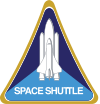STS-54
| Missionsemblem | |||||
|---|---|---|---|---|---|
 | |||||
| Missionsstatistik | |||||
| Missionsnavn: | STS-54 | ||||
| Rumagentur: | NASA | ||||
| Rumfærge: | Endeavour (3) | ||||
| Antal besætningsmedlemmer: | 5 | ||||
| Affyringsrampe: | LC-39A (KSC) | ||||
| Opsendelse: | 13. januar 1993 | ||||
| Landing: | 19. januar 1993 | ||||
| Landet på: | KSC | ||||
| Varighed: | 7 dage 22 timer | ||||
| Foto af besætningen | |||||
 | |||||
| Navigation | |||||
| |||||
STS-54 var Endeavours 3. rumfærge-mission. Opsendt 13. januar 1993 og vendte tilbage den 19. januar 1993.
Hovedformålet var opsætning af den 6. TDRS satellit, Tracking and Data Relay Satellite TDRS-6/TDRS-F.
Besætning

 John Casper (Kommandør)
John Casper (Kommandør)
 Donald McMonagle (Pilot)
Donald McMonagle (Pilot)
 Mario Runco (1. specialist)
Mario Runco (1. specialist)
 Gregory Harbaugh (2. specialist)
Gregory Harbaugh (2. specialist)
 Susan Helms (3. specialist)
Susan Helms (3. specialist)
Missionen
Eksterne henvisninger
- STS-54 NASA (engelsk)
| ||||||||
| ||||||||||||||||||||
Medier brugt på denne side
Forfatter/Opretter: Rei-artur (diskussion · bidrag), reshaped by F l a n k e r (talk), Licens: CC-BY-SA-3.0
symbol of Mars. 400 × 400 pixels nominal dimensions, line 45 pixel tick, circle 295 × 295 pixel, not joined with arrow. Colour: red=0 green=0 blue=140.
![]() Vektorgrafikken blev lavet med Inkscape.
Vektorgrafikken blev lavet med Inkscape.
Forfatter/Opretter: By Rei-artur (diskussion · bidrag)., Licens: CC-BY-SA-3.0
Venus/female symbol.
SVG version of PNG Space Shuttle Logo/Patch.
STS-54 Mission Insignia
Astronauts pictured in the STS-54 crew portrait from left to right are: Mario Runco, Jr., mission specialist; John H. Casper, commander; Donald R. McMonagle, pilot; and mission specialists Susan J. Helms, and Gregory J. Harbaugh. Launched aboard the Space Shuttle Endeavour on January 13, 1993 at 8:59:30 am (EST), the crew deployed the fifth Tracking and Data Relay Satellite (TDRS-6).
The Space Shuttle Endeavour shortly before docking with the International Space Station on NASA mission STS-111.
The Space Shuttle Endeavour approaches the International Space Station (ISS) in this digital still camera's view, recorded on June 7, 2002. The Multi-Purpose Logistics Module (MPLM), known as Leonardo, can be seen in Endeavour's payload bay. Two Russian cosmonauts and an American astronaut, currently onboard the shuttle, will replace two American astronauts and a Russian cosmonaut now on the station.
Astronauts Gregory Harbaugh and Mario Runco, Jr. during the EVA on STS-54.
STS-54 Mission Specialist (MS2) and extravehicular crewmember 1 (EV1) Gregory J. Harbaugh, wearing extravehicular mobility unit (EMU) (red stripes), carries EMU-suited MS1 and EV2 Mario Runco, Jr along Endeavour's, Orbiter Vehicle (OV) 105's, payload bay (PLB) starboard sill longeron during Detailed Test Objective (DTO) 1210, extravehicular activity (EVA) operations procedure/training. Harbaugh uses Runco's EMU mini-workstation as a handhold. The objective of this exercise is to simulate carrying a large object. It will also evaluate the ability of an astronaut to move about it space with a "bulky" object in hand. The empty airborne support equipment (ASE) frames appear below the crewmembers and the PLB aft bulkhead behind them. This EVA is the first in a series to broaden EVA procedures and training experience bases and proficiency in preparation for future EVAs such as the Hubble Space Telescope (HST) and Space Station Freedom (SSF).












